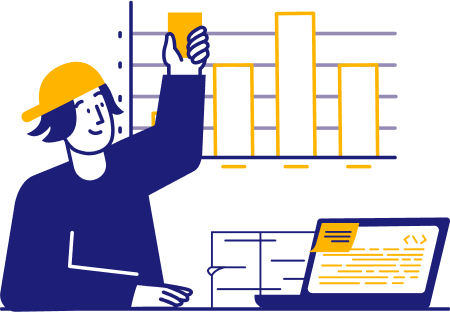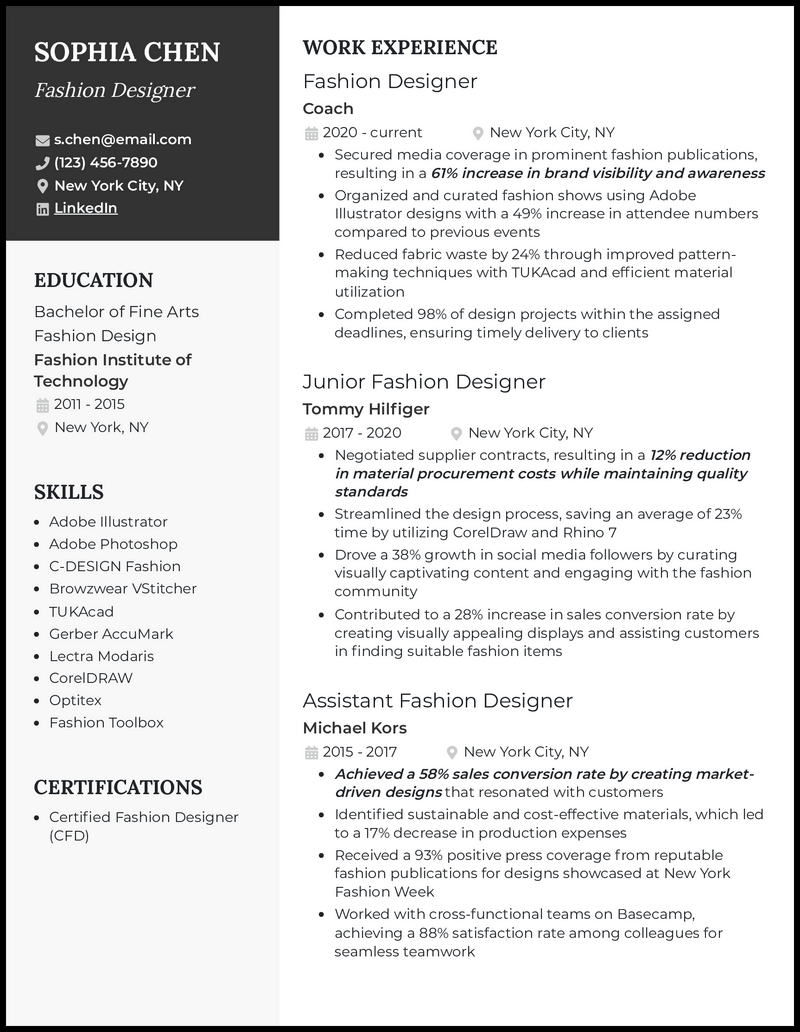You’re the one who makes sure each new fashion piece is stunning, from conception to construction. Shirts, shoes, dresses, accessories, textiles, and more. You know precisely what it takes to make a clothing piece memorable.
But which resume template will best showcase your spatial reasoning, trend knowledge, and material expertise?
Don’t worry about it! After years of helping people in the fashion industry, we’ve put together our cover letter maker and three fashion designer resume examples so you can get your spark started!
Related resume examples
What Matters Most: Your Skills & Professional Experiences

The skills section of your resume should indicate what you can do within your fashion designer role in a nice, impressive list.
Don’t use generic job skills like “design” that could apply to any job. Be specific! What style or part of a fashion piece do you design? What software programs do you use to bring fashion pieces and events to life?
Recruiters want details like the names of any field-specific tools or methods you use, and they want to see a well-rounded list that spotlights the extent of your knowledge.
9 best fashion designer skills
- C-DESIGN Fashion
- Adobe Photoshop
- Browzwear VStitcher
- TUKAcad
- Gerber AccuMark
- Lectra Modaris
- CorelDRAW
- Fashion Toolbox
- Optitex
- Trend Knowledge
Sample fashion designer work experience bullet points
Now that you have your set of “building blocks” in the form of your skills list, you can start building your work experience section to add some backstory! How have you created success with your abilities in the past? Recruiters want to know.
Look at areas where your previous jobs, internships, or academic experiences relate to fashion, design, creativity, and relevant materials you use on the job.
Always include quantifiable data that shows your final impact. Recruiters love those metrics! How many dollars did your textile inventory knowledge help save the company? When did your innovation earn a notable award that boosted brand awareness?
Here are a few samples:
- Secured media coverage in prominent fashion publications, resulting in a 61% increase in attendee numbers compared to previous events
- Streamlined the design process with CorelDRAW and Rhino 7, saving an average of 11 manual work hours per week on projects
- Received 93% positive press coverage from reputable fashion publications for designs showcased at New York Fashion Week
- Negotiated supplier contracts, resulting in a 12% reduction in material procurement costs while maintaining quality standards
Top 5 Tips for Your Fashion Designer Resume
- Keep it sleek and streamlined
- Each of your experience points should be concise. Recruiters are busy, and you want to make an impression! Tell what you did (coordinated promos for a fashion event), how and why you did it (what programs you used and what for), and then share a bit of contextual detail on how it helped.
- Consolidate jobs if you’re more experienced
- If you’ve been working your fashion magic for a while now, you might want to pare away some unrelated jobs from your resume’s experience section. You want to share only the best experiences from your best roles to make a great first impression!
- Seriously: Include internships if you need to
- The same goes for academic awards that relate to fashion design! Experiences don’t have to be top-tier jobs in a fashion-forward metropolis to still reinforce your credibility as a designer. If you learned applicable, translatable skills during an internship, volunteer outreach, or academic project, include it.
- Consider an objective vs. a summary
- If you’re struggling to flesh out your resume, you might want to write a brief resume objective stating why you want to be a fashion designer and how you’re qualified for the role. If you’re already experienced, a resume summary can help you tie your qualifying accomplishments together.
- Prioritize readability over visuals
- As a fashion designer, your eye for color, shape, and trend appeal will set you apart in your industry . . . But that doesn’t mean you should go wild on your resume. Keep to just a little pop of color, and keep your fonts readable and sleek enough for a Vogue cover!
Stick to a one-page resume! Remember, recruiters don’t have much time to spend on your resume. Just a few seconds on average, in fact. So make sure you take concision seriously, and if you have any “overflow experiences” that don’t fit, switch them out to fit each fashion designer job like a glove.
Yep, that’s another great spot for extra experiences you don’t want to part with but couldn’t fit in your resume. Adding a cover letter to your application package alongside your resume also shows your ability to think cohesively, which is key for a fashion designer!
You can organize your skills by grouping like abilities within the same section. That’s a great way to check your fashion design resume for redundancies you could eliminate and gauge how well-rounded your abilities currently look.








